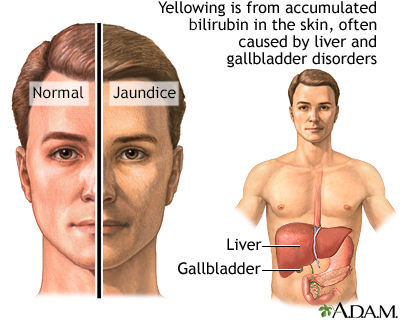Jaundice causes
Definition
Jaundice is a yellow color in the skin, mucous membranes, or eyes. The yellow color comes from bilirubin, a byproduct of old red blood cells. Jaundice is a sign of other diseases.
This article talks about the possible causes of jaundice in children and adults. Newborn jaundice occurs in very young infants.
Alternative Names
Causes of jaundice; Cholestasis
Information
Jaundice is often a sign of a problem with the liver, gallbladder, or pancreas. Jaundice can occur when too much bilirubin builds up in the body. This may happen when:
- There are too many red blood cells dying or breaking down (hemolysis) and going to the liver.
- The liver is overloaded or damaged.
- The bilirubin from the liver is not able to properly move into the digestive tract.
Conditions that can cause jaundice include:
- Infections of the liver from a virus (hepatitis A, hepatitis B, hepatitis C, hepatitis D, and hepatitis E) or a parasite
- Use of certain drugs (such as an overdose of acetaminophen) or reactions to other medicines or or exposure to poisons (for example, poisonous mushrooms)
- Birth defects or disorders present since birth that makes it hard for the body to breakdown bilirubin (such as Gilbert syndrome, Dubin-Johnson syndrome, Rotor syndrome, or Crigler-Najjar syndrome)
- Chronic liver disease
- Gallstones or gallbladder disorders causing blockage of the bile duct
- Blood disorders
- Cancer of the pancreas
- Bile buildup in the gallbladder because of pressure in the belly area during pregnancy (jaundice of pregnancy)
Gallery

References
Lidofsky SD. Jaundice. In: Feldman M, Friedman LS, Brandt LJ, eds. Sleisenger and Fordtran's Gastrointestinal and Liver Disease: Pathophysiology/Diagnosis/Management. 11th ed. Philadelphia, PA: Elsevier; 2021:chap 21.
Wyatt JI, Haugk B. Liver, biliary system and pancreas. In: Cross SS, ed. Underwood's Pathology. 7th ed. Philadelphia, PA: Elsevier; 2019:chap 16.